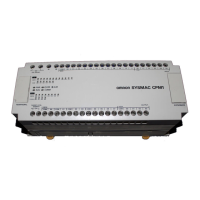324
Special Instructions Section 5-26
nated for tracing. (Refer to the SSS Operation Manual: C-series PCs for
details.)
TRSM(45) is not controlled by an execution condition, but rather by two bits in
the AR area: AR 2515 and AR 2514. AR 2515 is the Sampling Start bit. This
bit is turned ON to start the sampling processes for tracing. The Sampling
Start bit must not be turned ON from the program, i.e., it must be turned ON
only from the peripheral device. AR 2514 is the Trace Start bit. When it is set,
the specified data is recorded in Trace Memory. The Trace Start bit can be set
either from the program or from the Programming Device. A positive or nega-
tive delay can also be set to alter the actual point from which tracing will begin.
Data can be recorded in any of three ways. TRSM(45) can be placed at one or
more locations in the program to indicate where the specified data is to be
traced. If TRSM(45) is not used, the specified data will be traced when
END(01) is executed. The third method involves setting a timer interval from
the peripheral devices so that the specified data will be tracing at a regular
interval independent of the cycle time. (Refer to the SSS Operation Manual:
C-series PCs.)
TRSM(45) can be incorporated anywhere in a program, any number of times.
The data in the trace memory can then be monitored via a Programming Con-
sole, host computer, etc.
AR Control Bits and Flags The following control bits and flags are used during data tracing. The Tracing
Flag will be ON during tracing operations. The Trace Completed Flag will turn
ON when enough data has been traced to fill Trace Memory.
Note *Do not change the status of AR 2515 from the program.
Precautions If TRSM(45) occurs TRSM(45) will not be executed within a JMP(08) –
JME(09) block when the jump condition is OFF.
Example The following example shows the basic program and operation for data trac-
ing. Force set the Sampling Start Bit (AR 2515) to begin sampling. The Sam-
pling Start Bit must not be turned ON from the program. The data is read and
stored into trace memory.
When IR 00000 is ON, the Trace Start Bit (AR 2514) is also turned ON, and
the CPU Unit looks at the delay and marks the trace memory accordingly.
This can mean that some of the samples already made will be recorded as
the trace memory (negative delay), or that more samples will be made before
they are recorded (positive delay).
The sampled data is written to trace memory, jumping to the beginning of the
memory area once the end has been reached and continuing up to the start
marker. This might mean that previously recorded data (i.e., data from this
sample that falls before the start marker) is overwritten (this is especially true
Flag Function
AR 2515 Sampling Start Bit*
AR 2514 Trace Start Bit
AR 2513 Tracing Flag
AR 2512 Trace Completed Flag

